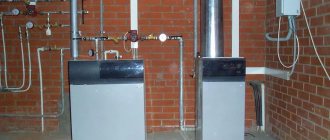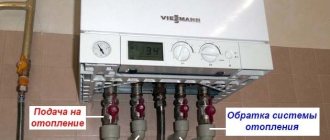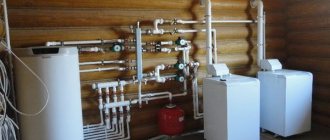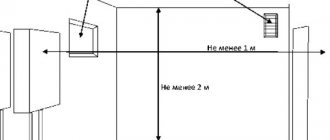Owners of country real estate at the stage of designing a heating system very often have a question: are there regulations allowing the installation of a gas boiler in the bathroom or should such an arrangement be immediately excluded?
You won’t believe it, but the question is really relevant, so next we will help you figure out whether there are any restrictive standards or not, and also whether it is worth entering into disputes with gas workers in court for the right to install a boiler in the bathroom or is this wasted time.
Installation: recommendations and diagrams, main stages of chimney installation
Chimney installation is divided into several stages - preparatory work, installation itself, then connection, startup and, if necessary, debugging of the entire system.
General requirements
When several heat-generating installations are combined, each of them creates its own chimney. In exceptional cases, a tie-in to a common chimney well is allowed, but a difference in height of at least one meter must be maintained.
First, the chimney parameters are designed and calculated, which are based on the recommendations of gas boiler manufacturers.
When summing up the calculated result, the internal cross-section of the pipe cannot be less than the diameter of the boiler outlet pipe. And according to testing according to NPB-98 (fire safety standards), the initial speed of the natural gas flow should be 6-10 m/sec. And besides, the cross-section of such a channel must correspond to the overall performance of the unit (8 cm2 per 1 kW of power).
Installation steps
Chimneys for gas boilers are mounted outside (attached system) and inside the building. The simplest is the installation of the outer pipe.
Installation of an external chimneySource astroyresurs.ru
Installing a chimney on a wall-mounted boiler is done as follows:
- A hole is cut in the wall. Then a piece of pipe is inserted into it.
- The vertical riser is assembled.
- The joints are sealed with a fireproof mixture.
- Fixed with wall brackets.
- An umbrella protecting from precipitation is fixed on top.
- An anti-corrosion coating is applied if the pipe is made of metal.
Proper installation of the chimney guarantees its impermeability, good draft, and does not allow soot to accumulate. Installation performed by specialists will significantly reduce the cost of maintaining this system.
When constructing an opening for a pipe in the roof of a house, special boxes with aprons are used. In this case, the design as a whole is influenced by such factors as:
- The material from which the pipe is made.
- External design of the chimney.
- Type of roof covering.
The main factor influencing the choice of design is the temperature of the gas that passes through the pipe. At the same time, according to standards, the distance between the chimney pipe and combustible materials must be at least 150 mm. The most advanced assembly system is considered to be in segments, where all elements are assembled using the cold forming method.
Sanctions for violation of norms
In case of violation of the requirements for the installation of gas-using systems, penalties may be imposed, followed by shutdown of the fuel supply and other unpleasant consequences.
Equipment is checked once a year, so during the next scheduled inspection, gas service employees may issue a fine.
If the mandatory rules of the joint venture regarding gas supply are ignored, the violator faces being disconnected from the main pipeline within 40 days.
In addition, leading boiler manufacturers will remove the warranty on appliance servicing if they deviate from safety standards.
Video description
How to install a chimney pipe, see the following video:
Connecting a ceramic chimney
Ceramic chimneys themselves are practically eternal, but since this is a rather fragile material, you need to clearly understand how to correctly connect (docking) the metal part of the chimney and the ceramic one.
Docking can only be done in two ways:
For smoke - a metal pipe is inserted into a ceramic
It is important to remember here that the outer diameter of the metal pipe should be smaller than that of the ceramic one. Since the thermal expansion of metal is much greater than that of ceramics, otherwise the steel pipe, when heated, will simply rupture the ceramic one.
For condensate, a metal pipe is placed over a ceramic pipe.
For both methods, specialists use special adapters, which, on one side, are equipped with a gasket for contact with a metal pipe, and on the other, which contacts directly with the chimney, are wrapped in a ceramic cord.
The joining should be carried out through a single-wall pipe - it has a higher heat transfer coefficient. This means that the smoke will have time to cool down a little by the time it reaches the adapter, which ultimately extends the service life of all materials.
Types of water heating equipment for the bathroom
Today, the range of devices for heating water is very wide and varied. The choice of equipment suitable for household needs depends on how many liters of water per day each family member needs. In addition, when purchasing a water heating device, it is necessary to take into account the following indicators:
- Energy source
- The location where the unit will be installed. For small apartments, it is advisable to choose compact water heating devices.
- Safety.
- Source of energy consumed.
- The amount of gas or electricity consumed.
If a number of problems may arise with the installation of gas-powered units in the bathroom, then the installation of water heating equipment in such parts of the house is permitted. That is why most apartment owners use storage tanks to heat water, which also provide heating for the bathroom.
Currently, the most common water heating devices are:
- Storage units for heating water.
- Instantaneous water heaters.
- Single-circuit and double-circuit boilers.
- Thermostatic mixer-water heater.
How to understand the documentation
The situation with permission to carry out installation is somewhat complicated by confusion in the official documentation. The fact is that the adopted Codes of Norms and Rules do not provide a clear explanation of whether gas boilers are allowed in bathrooms. Many employees of the state gas service refer to regulation 2.04.08 –87. It says about the ban on connecting gas boilers in bathrooms.
However, according to the resolution of the State Construction Committee of the Russian Federation dated December 23, 2002, the above documents and norms are considered invalid.
The new requirements (document 42-01-2002) do not contain clear instructions or a strict ban on the installation of gas equipment. As a result, misunderstandings arise. Some employees of the Gas Service simply refuse to install heating gas structures, without delving into the intricacies of the adopted documents and standards.
Without paperwork and collecting a large number of various permits, you can only install a new gas boiler or water heater in place of old appliances in the bathroom. In this case, if a place for such equipment is already provided, and, therefore, there is also permission, the employee will agree to make the connection.
Coordination of boiler installation
You need to go through several authorities to obtain approval for the installation of a gas-fired boiler. Doing it yourself, without approval, the installation process will be illegal and unsafe, and not only for the home owner, but also for the other residents of the house if the boiler is installed in a high-rise building.
Specifications
To connect a private house or apartment to the gas supply, you will have to obtain technical conditions from the gas supply organization that permit this procedure. To do this, a statement is written to the controlling organization. It must indicate the approximate demand for gas volume per hour. The registration procedure lasts seven to fourteen days. Upon successful completion of this event, a document will be issued - technical conditions for the installation of equipment operating on gas fuel. This is a permit for preparatory construction and installation work.
Project
Having the technical specifications in hand, you can proceed to the second step - developing design documentation. The gas supply project includes plans for laying a gas supply pipe from the boiler installation site to the central gas pipeline.
The project will also indicate sections of the gas pipeline crossing the site
If the home is located in the private sector, and the pipeline must cross the land, then a diagram of the gas pipe on the site is also drawn up, indicating the location of its entry into the wall of the house. The project is developed by engineers licensed for such activities, based on the provisions of the GOS.
Coordination with the gas supply organization
The completed project is submitted for approval to the organization that controls gas supply in the applicant’s area of residence. Project approval takes from seven to one hundred days, depending on the volume and complexity of the document. The following materials regarding the heating device are attached to the project:
- examination of the boiler’s compliance with all requirements necessary to ensure normal operation and safety;
- technical passport of the device;
- certificates of compliance with technical and sanitary-hygienic requirements;
- operating instructions.
All documents specified in the list are prepared by the manufacturer and must necessarily accompany any product of this type.
They are transferred by the seller to the buyer when purchasing the device - special attention should be paid to this
If the project was rejected for the first time, the applicant is given a document indicating the reasons for the refusal and a list detailing all the problems of the project that require correction.
If the project is approved, it is certified by the signature and seal of the responsible person. This document is the final permission to install the heating device.
Sequencing
If you are lucky and it is possible to install individual heating in the house, you will have to go through the authorities. Here's what to do:
- Write an application to the organization that supplies gas to install a gas boiler. After some time they give you a conclusion whether it is possible to install the boiler or not. If the conclusion is positive, consider that you have received permission to install a gas boiler in the apartment.
- Now you need an installation project. It is ordered from a design organization that has the right to make such documentation (you can contact the gas supply organization). At this stage, it is advisable to already decide on the brand of boiler and meter - a new project is being developed for them, the data is entered into the specification. Any change is then made for a fee (before signing, after the project is signed, you cannot change anything, just order a new one).
- Contact the fire inspection authorities for the address/number of the organization that checks the condition of chimneys/vent ducts. You make an agreement with a specialist from this company. He comes and checks the condition of the ventilation. If everything is fine, it issues permission to install the boiler. If he is not satisfied with the condition of the chimney, he issues a certificate indicating the necessary work. After correcting the deficiencies, call the specialist again and seek permission.
- Now you go to the heating network and submit an application to refuse the heating supply. If you heat hot water yourself, you also refuse it. After paying your debts (there is always something to pay for some reason), you specify the timing of the shutdown work. Until this time, you need to have a signed rework project from Gorgaz in your hands. Previously, at this stage – a failure in the heating network – problems could arise: they didn’t want to sign the application, they demanded payment for “heating” from the risers passing through the apartment, etc. But for several years now such problems have not been observed.
- You buy a gas meter and boiler, take the data to the design organization, and after entering this data, you pick up the finished project. It’s not worth buying units earlier - you may not get permission, and then what should you do with the equipment?
- You enter into an agreement for boiler maintenance at the Gorgaz branch (they sign the project only if there is an agreement) and submit the apartment gasification project for signature.
- Once you receive the signed project, you can cut off the heating network. This is not so simple: you will have to drain the water from the system of the entire house, in general, you will have to tinker.
- Installing your heating system. After hanging/installing the boiler, connect and power the system, check it for leaks and operability (without connecting to gas).
- At Gorgaz you agree on a date when they will come to you and weld/connect the pipes according to the project you have in hand. They redo everything, connect the boiler and stove, seal the meter, start the boiler and stove. Actually, you installed a heating boiler in the apartment.
- For a valid warranty on a gas boiler, adjustment and first start-up with a mark in the passport are also required. In this regard, contact the department where the boiler was placed for maintenance. The technician comes, adjusts the equipment, starts the system and puts a stamp in the passport. Now that's all. You can use the boiler.
This entire procedure takes from 1.5 to 3.5 months. Therefore, in order to enter the heating season without any rush, start the procedure in the spring, or, in extreme cases, at the beginning of summer. In terms of money, everything, together with documents and equipment (an average-cost boiler + pipes + radiators + fittings) costs about $3,000.
Some nuances of installing flow-through gas heaters in the toilet and bathroom
For owners of private cottages, there is another way to obtain official permission to install a boiler or gas heater in the bathroom. First, official documentation is drawn up when developing the project.
Install gas equipment in the part of the home where it is permitted. Then plumbing fixtures, such as a bathtub, are installed next to the fixture and a plasterboard partition is built around it. Such an improvised redevelopment, of course, cannot be called ideal. Subsequently, if the owner wants to sell the house, a number of problems may arise. Specialists from the Bureau of Technical Inventory will be able to conduct an examination only after dismantling the walls.
Officially, installation of a gas boiler is provided only for technical premises - storage rooms, change houses. If such rooms meet the requirements adopted for them, the installation of gas-fired water heaters is permitted.
Appearance of a floor-standing gas boiler
High levels of humidity in the bathroom and temperature fluctuations often lead to breakdowns of gas heating appliances. Before deciding to install it, it is worth considering all the advantages and disadvantages and assessing the financial feasibility of installing such equipment. Obtaining official permission from the relevant authorities is not easy; this can be done by applying some legal tricks.
Show or hide
Of course, we all want to make the bathroom the most comfortable and aesthetically pleasing room possible, because this is a territory not only of hygiene, but also of relaxation. Large-sized gas equipment that is not always attractive in appearance usually does not fit into our ideas of a beautiful and comfortable bathroom, although now you can find speakers on sale that can become a decoration for the bathroom.
It would seem that the most obvious solution is to hide the gas water heater inside the wall, but all standards and safety requirements strictly prohibit this. Therefore, if you do not want to leave your instantaneous water heater in plain sight, you can hide it in a plasterboard niche or in a closet.
This is interesting: Which bathtub is better, acrylic or cast iron?
What do you need to know when installing a gas boiler in a bathroom?
When looking for a convenient place to install a gas boiler, owners often stop at the bathroom or toilet. But to what extent is such placement allowed by SNiP rules and fire safety standards? Before installing a gas boiler in the bathroom, you should understand this issue in detail.
You are unlikely to find a clear answer to the question of whether it is possible to install a gas unit in a bathroom in the documentation. According to SNiP standards of 1987, the placement of such equipment in the bathroom is prohibited. However, later, since 2003, the cited SNiP was declared invalid and instead SNiP 42-01-2002 “Gas distribution systems” was put into effect. But it does not clearly indicate whether a gas boiler can be installed in a bathroom. You can only get an affirmative answer by contacting your gas supply company.
Important! Only a device with a closed, hinged combustion chamber can be installed in a bathroom or toilet. As practice shows, most gas workers prohibit the installation of gas equipment in the bathroom. The main reasons for refusal are the following:
The main reasons for refusal are the following:
As practice shows, most gas workers prohibit the installation of gas equipment in the bathroom. The main reasons for refusal are the following:
- requirements of old standards;
- insufficient room size;
- high humidity in the bathroom, which leads to rapid failure of equipment;
- interruption of traction due to mixing of moisture with combustion products.
It’s easier for those who already had a gas boiler in their bathroom or toilet. Then they replace the old unit with a new one without much paperwork.
However, some owners resort to tricks and, in order to obtain permission from the gas service, pass off the future bathroom as a furnace room. And after installing the unit, a shower and sink are also placed there. But such a violation is fraught with negative consequences in the form of fines and disconnection from the gas main. The fact is that gas workers are required to periodically check the gas equipment located in the house, so in a year or two the fraud will still be discovered and you will have to pay dearly for it.
If, despite the refusal, you are ready to continue to seek permission to install the unit in the bathroom, then you can go the following way:
- You need to submit a request to the head of the gas service to connect a heating device in the bathroom. In this case, you should attach a list of regulatory documents that allow you to do this.
- If you are refused, you can file a claim in court, where you can always win the case.
Pros and cons of installing a gas boiler in the bathroom
Many people are attracted to installing a gas device in the bathroom for the following reasons:
- compact location;
- the unit is not “conspicuous” and does not interfere with movement;
- hot water is immediately supplied to the main water intake points - the sink and shower.
There are also disadvantages to this arrangement:
- high humidity negatively affects the metal parts of the device;
- bathrooms usually have small dimensions, so even a compact wall-mounted unit will take up quite a lot of space;
- there is a high probability that in order to meet all safety requirements, the bathroom will have to be re-equipped.
Think carefully about whether such placement of a gas boiler is suitable in your case. Perhaps the best installation option would be a kitchen or hallway.
What requirements must a bathroom meet?
It is important to understand that not every bathroom is suitable for installing a gas boiler. For example, standard bathrooms in ordinary Khrushchev or 9-story buildings built in the 70s and 80s are too small and do not have sufficient ventilation. In order for it to make sense to even consider the possibility of installing a gas boiler in the bathroom, it must meet certain requirements:
In order for it to make sense to even consider the possibility of installing a gas boiler in the bathroom, it must meet certain requirements:
- total area of at least 7.5 m²;
- the presence of a working ventilation system;
- there must be a window with an area of at least 0.25 m²;
- ceiling height not lower than 2 m;
- when the door is closed, there should be a gap of 1-2 cm between it and the floor;
- there should be nothing in front of the unit at a distance of 1 m;
- Bathroom walls must be made of non-combustible materials.
Thus, from the above requirements it is clear that apartment owners in multi-storey buildings are practically deprived of the opportunity to install a gas boiler in the bathroom. The owners of private houses have a better chance, since they can initially build a bathroom that meets all the given standards.
No comments yet
Answers from experts
Generous:
it is possible but is it necessary? another place can be found
Yuri Morozenkov:
Would you like to wash between the pipes?
Ivan Kuleshov:
Theoretically, it is possible, this particular Ariston has an IP X4D protection class, you can hang it in the bathroom. Another question is whether the area of the room allows this to be done.
Maria:
You will not meet the requirements for the dimensions of the room and the presence of fresh ventilation - windows with a window. Or more precisely, ask your gas workers; anyway, you will draw up the project and have it certified by them.
Vladimir Petrov:
Here I am reading the passport for a boiler with a closed combustion chamber. They can be located in the bathroom in zone 3 at a distance of min. 60cm from the edge of the bathtub or shower. And you need to ground current-carrying parts in accordance with CSN 33 2000-4. So you can bet. If only the bathroom wall faced the street, the exhaust would flow.
Truculentus:
6.37.* Installation of water heaters, heating boilers and heating devices should be provided in kitchens and non-residential premises intended for their placement and meeting the requirements of paragraphs. 6.42 * and 6.43 . THE INSTALLATION OF THE SPECIFIED DEVICES IN BATHROOMS IS NOT ALLOWED. The issue of the need to move gas water heaters from bathrooms, in which they were placed in accordance with previously existing standards, to kitchens or other non-residential premises of a residential building during the reconstruction of a house or gas supply system, should be decided on a case-by-case basis by the design organization in agreement with local operating organizations gas industry. In existing residential buildings, it is allowed to provide for the installation of gas heating appliances and heating devices in corridors for individual use that meet the requirements of paragraphs. 6.42 * and 6.43 .
The distance from the protruding parts of gas burners or fittings to the opposite wall must be at least 1 m.
Verik:
I don’t see a problem with this... hang it up, there’s protection there
Spitz Pomeranian:
I agree with Verkisto. The gas service will not allow it.
Henry Hayes:
A friend of mine has an Aristonov wall mount (genus with a boiler) installed in the bathroom. But they have a private house according to the Ind. project built and a bathroom with a total area of 9 square meters. So - if the space allows, then hang the boiler wherever you want.
Vyacheslav:
)))))))))))))) why not ask the organizations that give permission?
AVR TECH:
no, it's better to put it in the kitchen
Cafe bar Ermak:
The gas boiler MUST be placed in a room where there is natural ventilation (window)
Truculentus:
Can be installed in the bathroom if this room meets the requirements for installing a gas boiler. Details about the requirements: SP 42-101-2003 SNiP 42-01-2002
Alexei:
and in the requirements... room area... separate entrance... glazing area... free access for maintenance personnel... inflow cross section...
It’s better to place the bathroom in the same room as the instantaneous boiler. The water will be regulated faster by the tap)))
Tatyana Otmakhova:
I doubt that the VDPO will sign the act. Call the VDPO in your city, they will tell you everything in detail.
Vlad:
Where in the project (BTI documents) it should be there. Otherwise, redevelopment. With mandatory approval from the gas supply organization. 99 percent of the time they won’t give it. What did you write about above?
Regulatory framework governing the field
Improper use of gas equipment often leads to negative consequences. Therefore, the state regulated this area to the smallest detail.
And, due to this feature, one, even a voluminous document, will not be able to contain all the necessary information.
All necessary rules for installing gas boilers are set out in the relevant governing documents. But the problem is that there are many of them and it will take a lot of time to get to know them. Therefore, in most cases you have to rely on specialists
As a result, there are really a lot of all kinds of instructions. For example, certain related issues are regulated by:
- SP-401.1325800.2018, which sets out the design rules for all kinds of gas consumption systems in residential buildings;
- SP 62.13330.2011, which indicates what the gas pressure should be, how to properly lay pipes to the boiler, etc.;
- GOSTs with numbers R 52318-2005; R 58121.2-2018; 3262-75. Where it is indicated which pipes and connecting elements can and should be used when installing a gas boiler. In addition, steel and other types of gas pipelines are described. And also their characteristics are indicated;
- GOST 27751-2014; SP 20.13330. These documents set out the requirements for the load on external and internal gas pipelines used to install boilers;
- SP 402.1325800.2018, which sets out the rules for connecting boilers to electrical networks;
- SP 28.13330, and in some cases GOST 9.602-2016, which describes methods for combating corrosion;
- SNiP 21-01-97. This document outlines the safety measures that should be observed when operating buildings, including those heated by gas boilers. Building materials are also divided into flammable and non-combustible. And such information is important when equipping the room in which the boiler will be placed.
In addition, you should familiarize yourself with the rules set out in SP 60.13330.2016 (this document is an updated version of the well-known SNiP 41-01-2003). After all, it is precisely this by-law that states that individual heating sources can be used to heat housing and what they should be.
And this is not all you need to know to guarantee the correct placement of the boiler and further safe operation.
It is mandatory to comply with the current requirements when installing boilers. Because otherwise, the specified unit simply will not be allowed for operation. And for unauthorized connection there are strict sanctions in the form of large fines (from 10 thousand rubles). This is stated in Art. 7.19 of the Administrative Code, as well as in Art. 215.3 of the Criminal Code
And, if, for example, the question arose about why you need to know safety measures or loads on pipes during construction. Then you should remember that the installed boiler will be allowed for operation. And, when the established rules set out in the profile document are not followed, the identified shortcomings will have to be eliminated.
In the case when a purchased gas boiler is being installed in your own wooden house and the requirements for the size of the foundation are not met, which at any point must exceed the dimensions of the boiler by at least 30 cm. Then, instead of enjoying comfort, you will have to dismantle the structure and perform new work.
Conclusion
When arranging your boiler room, it is best to consult with a knowledgeable gas service specialist in your region. Because, as inspectors checking the installation of heating equipment, they can find any reason to draw up an order with aggravating conditions or a fine. It is better to comply with all instructions from gas workers and similar services in advance. You can get acquainted with the opinions of your neighbors on equipping a room with a boiler, and get acquainted with information on the Internet. Then you will never pay extra money to representatives of the gas or chimney and ventilation services for servicing chimneys and other “inventions” of enterprising workers of such services. If there are no conditions for installing floor-standing boilers, it is better to install wall-mounted boilers that do not require such stringent requirements regarding the premises. However, when installing suspended structures, special conditions are imposed on the distribution pipeline system, couplings and adapters.
Source Source https://septik.guru/vannaya-komnata-i-tualet/pochemu-nelzya-ustanavlivat-gazovyj-kotel-v-vannoj-komnate-pravila-i-prichiny-zapreta.html https://101studio.ru /kotly/mozhno-li-v-kotelnoj-postavit-stiralnuyu-mashinu.html
Advantages of gas heating
Everyone knows that residents of apartment buildings in the city pay much more for heating their homes than people living in country houses. What is this connected with?
First of all, with the fact that prices for heating and hot water are too high, and sometimes simply unreasonably high. At the same time, the temperature in the apartment often does not correspond to the norm, so there cannot be any pleasure from such a stay.
To solve the problem, some townspeople install an autonomous heating system with a gas boiler, the advantages of which are obvious:
- Autonomy - independence from hot water suppliers. And gas shortages are extremely rare.
- Creating a comfortable level of heat in rooms with the ability to regulate it.
- In addition to heating the home, it is possible to use hot water.
- Significant financial savings when paying for housing and communal services.
- Creating coziness and comfort regardless of the beginning of the heating season - at any time, in cold weather, in autumn and spring, you can independently turn on the heating of the apartment.
Where is it possible to install a gas boiler?
Installing a gas boiler in a house must meet certain requirements. Moreover, they are mandatory, regardless of whether it works for hot water supply or not.
1. The boiler should be installed in a separate room with an area of at least 4 m2, and the ceilings must be at least 2.5 meters. The rules also indicate the volumetric size of the room - at least 4 m3.
2. In a room with a boiler, an opening window or window is required. The door must be no less than 80 cm wide.
3. Interior decoration made of flammable materials is prohibited. Suspended ceiling technology is prohibited.
4. It is necessary to organize a constant flow of fresh air into the room. The inflow opening must be constantly open, and its cross-section must be from 8 cm2 for every 1 kW of the declared power of the heating equipment.
Please pay attention! In order to install a gas boiler in a house with a power of 30 kW, you need 8 m3 of free space. Further increasing the power - for 31-60 kW, 13.5 8 m3 must be provided, for 61-200 kW, 15 m3 of free volume is required. In addition, for the operation of heating equipment of any type, the following standards must also be provided:
In addition, for the operation of heating equipment of any type, the following standards must also be ensured:
- The exhaust pipe must be routed into a separate flue. Connection to ventilation ducts is prohibited.
- The horizontal flue should be no more than 3 meters long indoors. It is allowed to organize no more than three corners and turns.
- The flue exits the house vertically. The height is 1 meter greater than the highest point of the pediment.
- The chimney must be made of bases highly resistant to chemical and thermal influences. The use of a layered base (asbestos-cement pipes) is permitted only at a distance of 5 meters from the edge of the outlet pipe.
When connecting a gas boiler in the kitchen, the following requirements are also added:
- The hanging height of the boiler must be organized according to the following scheme - the lowest pipe should not be lower than the top of the spout at the sink. However, in any case, the height from the floor should not be less than 80 cm.
- There must be free space under the hung boiler.
- The floor under gas equipment must be covered with a metal sheet (size 1000 x 1000 mm). The requirements of gas workers and the fire service do not allow asbestos-cement coatings, because it wears off over time. On the other hand, the requirements of the SES do not allow the presence in the house of elements that contain asbestos.
- Premises with gas equipment should not have any cavities in which explosive mixtures or combustion products can accumulate.
As you can see, the rules strictly regulate the installation process. However, there is a justification for this, because... gas is a dangerous thing. That is why you can forget about installing a gas boiler if:
1. You are the owner of an apartment in a multi-storey building (Khrushchev), which does not have a main gas duct.
2. The kitchen has equipped false ceilings or heavily made wooden furniture.
3. In the absence of privatization for the apartment. Only installation of a water heating device is possible. The thing is that redevelopment will be required, which only the owners are allowed to carry out.
In other cases, the installation of water heating boilers in apartments is permitted. Wall heating is allowed, but with floor heating there will be big problems.
A private house will be simpler in this regard. In such a case, there are no clear requirements for installing a boiler room in the house itself. You can build an extension that does not raise unnecessary questions.
In private housing, the best option would be to install a wall-mounted boiler. It will not require the installation of cunning protective structures.
Ways to get around the ban
Some particularly smart home owners are trying to circumvent this ban.
Even at the design stage, a spacious kitchen is provided in which gas equipment is installed and registered. And after commissioning, plasterboard partitions are installed and plumbing fixtures are installed in the resulting room.
Of course, this is done mainly in private houses; in apartment buildings, such redevelopment is most often technically impossible.
It’s good if the gas service is full of acquaintances who will turn a blind eye to the position of the boiler during the inspection, but most likely, on their first visit they will write you a report on the unacceptable placement of equipment
But at the same time, the above reasons already seem reasonable enough not to do this. You also need to take into account that modern gas boilers have a connection to electricity, which requires increased protection against electric shock even in an ordinary room, not to mention a humid environment.
You must understand that regulatory requirements for the safety of installation of gas-using equipment are developed for the benefit, protection of health, life and property of people and they are quite justified from a technical point of view.
Features of kitchen renovation and design with a gas water heater
When planning the design and renovation of a kitchen with a gas heater, you need to take into account fire safety rules, ventilation and ergonomic requirements. Here are some important tips to help you design your workspace in the best possible way.
- If you are equipping a kitchen from scratch, then it is advisable to think about the location of the gas water heater, layout and interior design even before renovating and purchasing furniture. Then you will have more room for maneuver and fewer problems. For example, you can move the speaker, change it to a more modern model or one that suits the future environment, improve the ventilation and chimney at the same time, adjust the color scheme of the interior to match the speaker, etc.
- It is advisable to purchase a kitchen set to order, regardless of whether you plan to build the water heater into a cabinet or not. This will allow you to arrange your headset without errors and use every centimeter to your advantage.
- Is it possible to install a suspended ceiling in a kitchen with a gas water heater? It is possible if the height of the room with the sheet installed is at least 2.25 m, and there remains a distance of at least 8 cm from the chimney opening to the ceiling. In this case, it is advisable to equip the chimney not with an aluminum corrugated pipe, which gets very hot, but with a sandwich chimney with thermal insulation layer. This way, the ceiling will not be damaged by heat (from combustion products going into the chimney) and will not itself become an obstacle to draft. If necessary, the chimney opening can be lowered slightly.
- The walls in a kitchen with a gas water heater should not be decorated with wallpaper or plastic panels (at least near the water heater), as these materials can deteriorate/melt under the influence of heat. Ideally, the walls should simply be plastered, painted or finished with ceramic tiles (see photo).
Small kitchen with geyser and walls lined with ceramic tiles
- In a kitchen with a gas water heater, a constant flow of fresh air is required (50-90 cubic meters per hour). This is necessary both for your safety and for the combustion stability of the unit. Therefore, when installing plastic windows, choose those that have a micro-ventilation function, that is, special fittings that allow you to open windows with micro-slots from 3 to 7 mm. Both in winter and in summer, kitchen windows with a gas water heater should be opened in this mode. If wooden windows are planned or have already been installed in the kitchen, then due to their natural micro-slits the issue of passive ventilation will be resolved by itself. The main thing is not to overdo it with waterproofing, seals and window insulation.
- Supply ventilation valves embedded in the wall, for example, Kiv-125 or KPV-125, will help ensure air flow even more effectively. It is advisable to take care of their installation before repairs, so as not to spoil the finish.
- In a kitchen with a gas water heater, both the supply and exhaust systems must work in a balanced manner. Therefore, it is necessary to invite professional ventilation specialists to check the chimney and ventilation duct. If necessary, they need to be put in order. And, of course, when arranging your kitchen, do not make the most serious and, unfortunately, common mistake - do not cover the ventilation duct with plasterboard boxes, wallpaper, or furniture.
- And the last piece of advice - “in any unclear situation,” consult the gas service and act in accordance with the requirements of regulatory documents.
Designs for masking the boiler
At the initial stage, it should be taken into account that manufacturers of water heaters provide at least an average level of decorative value for the body of the water heater, meaning its installation on walls or on the floor without additional camouflage.
Thus, choosing a ready-made cabinet for a bath, hallway, kitchen or corridor, inside which a water heater will ideally fit, without gaps and dismantling some shelves, is a very difficult task. Since the owner does not yet have either a cabinet or a boiler, he runs around the shops and compares their mutual dimensions until they are completely compatible.
The exception is “under the sink”, “under the sink” boilers installed in floor cabinets. However, they are all low-power, since it is physically impossible to stuff large-volume tanks into small-sized furniture.
Therefore, structures inside which a storage water heater can be hidden are usually built by a home craftsman himself.
Box
A box is a structure that protrudes outward relative to the plane of the wall. Roughly speaking, this is a cabinet made of gypsum plasterboard sheets screwed onto a frame made of galvanized profile. Unlike a cabinet, the structure is stationary and non-removable. Instead of a door for access to the interior, an inspection hatch is used - hinged, sliding, push-button, removable.
The box manufacturing technology is as follows:
- fastening, piping the water heater (this will be problematic to do later);
- fixing the guide profile; Attaching the starting profile.
- installation of a rack profile;
- frame assembly;
Frame installation - installation of an inspection hatch;
- covering the frame with plasterboard;
Fastening gypsum board sheets. - finishing of external surfaces with tiles.
The box can be vertical from the ceiling to the floor or half the length of the wall, horizontal, stepped, of a complex configuration, depending on where the water supply and boiler are located.
Niche behind the toilet
Unlike the previous option, the niche is sewn up with one panel; there are no sides.
Material consumption is reduced and the labor intensity of the process is reduced.
A popular way to disguise engineering systems and water heaters in the niche behind the toilet are blinds, as in the bottom photo.
Pipes may interfere with fixing the electrical appliance to the wall using standard fasteners. In this case, brackets or special fastening systems are used.
Adjustable fastening system made of profile perforated pipe with brackets.
In this case, a stepped box is used, the wall is built up only above the toilet.
Niche under the kitchen window
Step-by-step instructions for hidden installation of a storage water heater in a niche under a kitchen window are as follows:
- dismantling standard doors, shelves lining internal surfaces;
- sewerage, electrical, water supply installations;
- finishing niche surfaces;
- installation of a water heater, installation of engineering systems;
- installation of inspection hatch, sliding and swing doors, blinds.
Access to the water heater body is necessary in order to clean the tank from scale and change the anodic protection electrodes.
Mezzanine
In the standard version, the mezzanine shelf is used to store household items. In this case, the purpose of this architectural structure changes. The shelf is equipped with blinds or doors, and a storage boiler is installed on it. The sequence of operations for manufacturing a mezzanine for a water heater is as follows:
- horizontal mark on opposite walls of the corridor;
- fastening bars or profiles to walls;
- laying the shelf on profiles/bars;
Installation of the mezzanine step by step. - installation of doors or blinds;
- installation of a water heater, connection to the electrical network, water supply, sewerage.
Installation of the boiler on the mezzanine.
Attention: Only horizontal models of water heaters must be installed on the mezzanine. It is not allowed to lay vertical boilers on their sides.
Wall cabinet
The option of installing a single-circuit electric boiler in an industrially manufactured wall cabinet is the least labor-intensive, but the most costly in terms of finances. The main installation nuances are:
- the standard cabinet fasteners will not support the weight of a storage heater with a full tank of water;
- the boiler is attached directly to the wall, either through the back wall of the furniture, or after its dismantling;
- to connect to sewerage, cold water, and hot water circuits, it is best to install water sockets inside the cabinet on the wall of the room;
- To connect to a 220 V network, an electrical outlet with grounding is inserted into the cabinet in the same way.
Plastic and composite pipes are always cheaper than long flexible metal hoses and last several times longer.
Closet
The interior solution “boiler inside a wardrobe” is optimal for a corridor or hallway. It is in these rooms that such furniture is used most often, and they are located in close proximity to the bathroom and kitchen. You can connect to the sewer/water supply through the wall. To do this, the back or side wall of the wardrobe must be the enclosing structure of a bath, toilet or kitchen.
The design of the built-in wardrobe is extremely simple - the doors move from ceiling to floor on rollers along guides, there are no side or rear walls. The upper part of one furniture compartment is allocated for the boiler; standard shelves for storing things are installed in the remaining space.
Floor stand
Due to the small size of bathroom cabinets and floor cabinets for kitchen sinks, it is impossible to fit a large-volume storage single-circuit electric boiler inside this furniture. Single-door cabinets accommodate a device with a maximum 30 liter tank, double-door cabinets - with a 80 liter tank.
Water heaters are installed on a cabinet shelf or attached to the wall of the room, and may have legs.
Selecting a gas device
A geyser is a device that is not purchased for a day or a month. Such a mechanism should serve you for years without causing any complaints.
To make your choice the most practical and effective, when choosing a geyser, pay attention to the following parameters:
Gas water heater performance
This most important criterion is responsible for the volume of water that the device can heat in one unit of time. As we mentioned, speakers are divided into low, medium and high power products.
Your choice depends on the following nuances:
- your personal needs;
- number of people living in the house;
- number of intake points: the mechanism can heat water not only for the bathroom, but also for the kitchen.
A gas boiler can heat water for the kitchen and bathroom
If each aspect is higher, you need to give preference to a more powerful product.
Ignition type
The column can be ignited by matches (a lighter), a piezo that provides a spark, or automatic equipment.
Such a mechanism is both safer and more convenient.
Burner type
This nuance is very important, because some models require your intervention, which is not very practical. For example, a constant power burner requires manual adjustment. And the modulating power burner independently adjusts to frequently changing water pressure, guaranteeing a stable temperature level.
Removal of combustion products
At this point, you need to choose a turbocharged or chimney engine. In the first case, all waste is removed through the pipe simply into the street, in the second case - into the chimney.
There are two options for waste disposal: turbocharged or chimney method
Safety
Each device has several levels of security. Experts recommend purchasing a product with three degrees of protection for the bathroom. Such mechanisms have the following protective functions:
ionization sensor: self-blocking; if the flame goes out, the draft level will decrease or disappear altogether; overheating sensor: pay attention to the presence of a hydraulic safety valve that will protect the mechanism from overheating; combustion sensor: the system will automatically shut off the gas supply if the flame goes out and the ionization sensor does not work; draft sensor: protects the column from turning on or off in the absence of draft; water temperature sensors.
Each of the sensors is optional, but you must admit that with them you will be much calmer.
We have presented to you the most important five criteria that will determine the quality and durability of a new bathroom device. However, do not forget about the manufacturer, which is also important when choosing a speaker.
Valliant geyser
Among the world's manufacturers of such equipment, the following names enjoy the greatest confidence:
- Ariston;
- Termaxi;
- Vaillant;
- Beretta.
Gas water heaters produced by the presented manufacturers are considered the golden mean in the equipment market. Such companies offer a wide selection of devices at different prices, and most importantly, of high quality.











